Mental Health: Trauma-Informed Care and Practice
VerifiedAdded on 2023/06/07
|12
|3261
|273
AI Summary
This article discusses the importance of trauma-informed care and practice in mental health, with a focus on the case of Mary-Jane who has been diagnosed with borderline personality disorder. It also highlights the need for culturally sensitive care for Aboriginal clients. The article provides recommendations for workers in non-trauma sensitive services and ways to raise the issue of traumatic experiences with clients. It also includes a discussion on reputable sources of research and information, evaluation of internet sources, and professional development opportunities.
Contribute Materials
Your contribution can guide someone’s learning journey. Share your
documents today.

Running head: MENTAL HEALTH
Cluster 6- Written Assignment
Name of the Student
Name of the University
Author Note
Cluster 6- Written Assignment
Name of the Student
Name of the University
Author Note
Secure Best Marks with AI Grader
Need help grading? Try our AI Grader for instant feedback on your assignments.
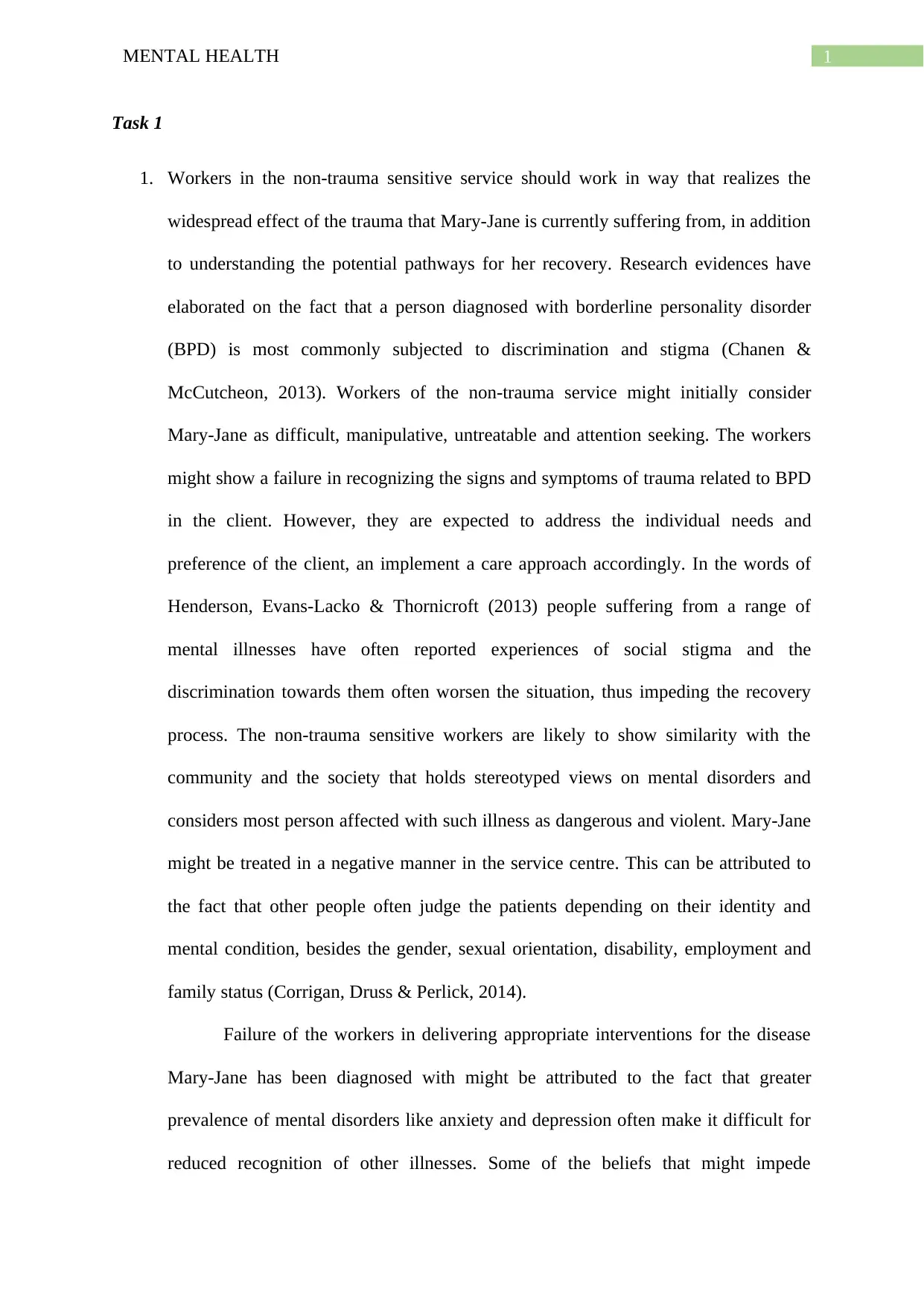
1MENTAL HEALTH
Task 1
1. Workers in the non-trauma sensitive service should work in way that realizes the
widespread effect of the trauma that Mary-Jane is currently suffering from, in addition
to understanding the potential pathways for her recovery. Research evidences have
elaborated on the fact that a person diagnosed with borderline personality disorder
(BPD) is most commonly subjected to discrimination and stigma (Chanen &
McCutcheon, 2013). Workers of the non-trauma service might initially consider
Mary-Jane as difficult, manipulative, untreatable and attention seeking. The workers
might show a failure in recognizing the signs and symptoms of trauma related to BPD
in the client. However, they are expected to address the individual needs and
preference of the client, an implement a care approach accordingly. In the words of
Henderson, Evans-Lacko & Thornicroft (2013) people suffering from a range of
mental illnesses have often reported experiences of social stigma and the
discrimination towards them often worsen the situation, thus impeding the recovery
process. The non-trauma sensitive workers are likely to show similarity with the
community and the society that holds stereotyped views on mental disorders and
considers most person affected with such illness as dangerous and violent. Mary-Jane
might be treated in a negative manner in the service centre. This can be attributed to
the fact that other people often judge the patients depending on their identity and
mental condition, besides the gender, sexual orientation, disability, employment and
family status (Corrigan, Druss & Perlick, 2014).
Failure of the workers in delivering appropriate interventions for the disease
Mary-Jane has been diagnosed with might be attributed to the fact that greater
prevalence of mental disorders like anxiety and depression often make it difficult for
reduced recognition of other illnesses. Some of the beliefs that might impede
Task 1
1. Workers in the non-trauma sensitive service should work in way that realizes the
widespread effect of the trauma that Mary-Jane is currently suffering from, in addition
to understanding the potential pathways for her recovery. Research evidences have
elaborated on the fact that a person diagnosed with borderline personality disorder
(BPD) is most commonly subjected to discrimination and stigma (Chanen &
McCutcheon, 2013). Workers of the non-trauma service might initially consider
Mary-Jane as difficult, manipulative, untreatable and attention seeking. The workers
might show a failure in recognizing the signs and symptoms of trauma related to BPD
in the client. However, they are expected to address the individual needs and
preference of the client, an implement a care approach accordingly. In the words of
Henderson, Evans-Lacko & Thornicroft (2013) people suffering from a range of
mental illnesses have often reported experiences of social stigma and the
discrimination towards them often worsen the situation, thus impeding the recovery
process. The non-trauma sensitive workers are likely to show similarity with the
community and the society that holds stereotyped views on mental disorders and
considers most person affected with such illness as dangerous and violent. Mary-Jane
might be treated in a negative manner in the service centre. This can be attributed to
the fact that other people often judge the patients depending on their identity and
mental condition, besides the gender, sexual orientation, disability, employment and
family status (Corrigan, Druss & Perlick, 2014).
Failure of the workers in delivering appropriate interventions for the disease
Mary-Jane has been diagnosed with might be attributed to the fact that greater
prevalence of mental disorders like anxiety and depression often make it difficult for
reduced recognition of other illnesses. Some of the beliefs that might impede
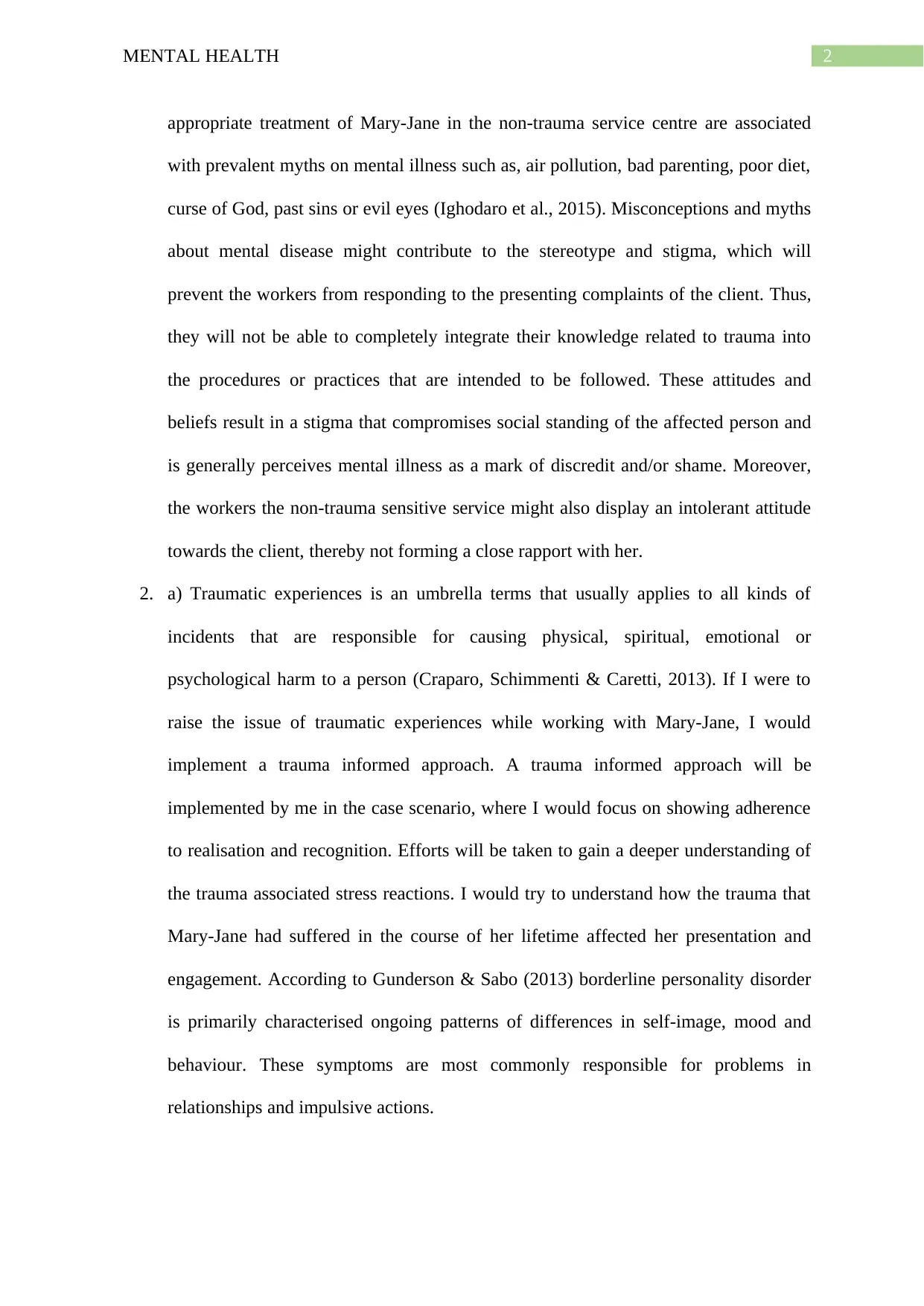
2MENTAL HEALTH
appropriate treatment of Mary-Jane in the non-trauma service centre are associated
with prevalent myths on mental illness such as, air pollution, bad parenting, poor diet,
curse of God, past sins or evil eyes (Ighodaro et al., 2015). Misconceptions and myths
about mental disease might contribute to the stereotype and stigma, which will
prevent the workers from responding to the presenting complaints of the client. Thus,
they will not be able to completely integrate their knowledge related to trauma into
the procedures or practices that are intended to be followed. These attitudes and
beliefs result in a stigma that compromises social standing of the affected person and
is generally perceives mental illness as a mark of discredit and/or shame. Moreover,
the workers the non-trauma sensitive service might also display an intolerant attitude
towards the client, thereby not forming a close rapport with her.
2. a) Traumatic experiences is an umbrella terms that usually applies to all kinds of
incidents that are responsible for causing physical, spiritual, emotional or
psychological harm to a person (Craparo, Schimmenti & Caretti, 2013). If I were to
raise the issue of traumatic experiences while working with Mary-Jane, I would
implement a trauma informed approach. A trauma informed approach will be
implemented by me in the case scenario, where I would focus on showing adherence
to realisation and recognition. Efforts will be taken to gain a deeper understanding of
the trauma associated stress reactions. I would try to understand how the trauma that
Mary-Jane had suffered in the course of her lifetime affected her presentation and
engagement. According to Gunderson & Sabo (2013) borderline personality disorder
is primarily characterised ongoing patterns of differences in self-image, mood and
behaviour. These symptoms are most commonly responsible for problems in
relationships and impulsive actions.
appropriate treatment of Mary-Jane in the non-trauma service centre are associated
with prevalent myths on mental illness such as, air pollution, bad parenting, poor diet,
curse of God, past sins or evil eyes (Ighodaro et al., 2015). Misconceptions and myths
about mental disease might contribute to the stereotype and stigma, which will
prevent the workers from responding to the presenting complaints of the client. Thus,
they will not be able to completely integrate their knowledge related to trauma into
the procedures or practices that are intended to be followed. These attitudes and
beliefs result in a stigma that compromises social standing of the affected person and
is generally perceives mental illness as a mark of discredit and/or shame. Moreover,
the workers the non-trauma sensitive service might also display an intolerant attitude
towards the client, thereby not forming a close rapport with her.
2. a) Traumatic experiences is an umbrella terms that usually applies to all kinds of
incidents that are responsible for causing physical, spiritual, emotional or
psychological harm to a person (Craparo, Schimmenti & Caretti, 2013). If I were to
raise the issue of traumatic experiences while working with Mary-Jane, I would
implement a trauma informed approach. A trauma informed approach will be
implemented by me in the case scenario, where I would focus on showing adherence
to realisation and recognition. Efforts will be taken to gain a deeper understanding of
the trauma associated stress reactions. I would try to understand how the trauma that
Mary-Jane had suffered in the course of her lifetime affected her presentation and
engagement. According to Gunderson & Sabo (2013) borderline personality disorder
is primarily characterised ongoing patterns of differences in self-image, mood and
behaviour. These symptoms are most commonly responsible for problems in
relationships and impulsive actions.
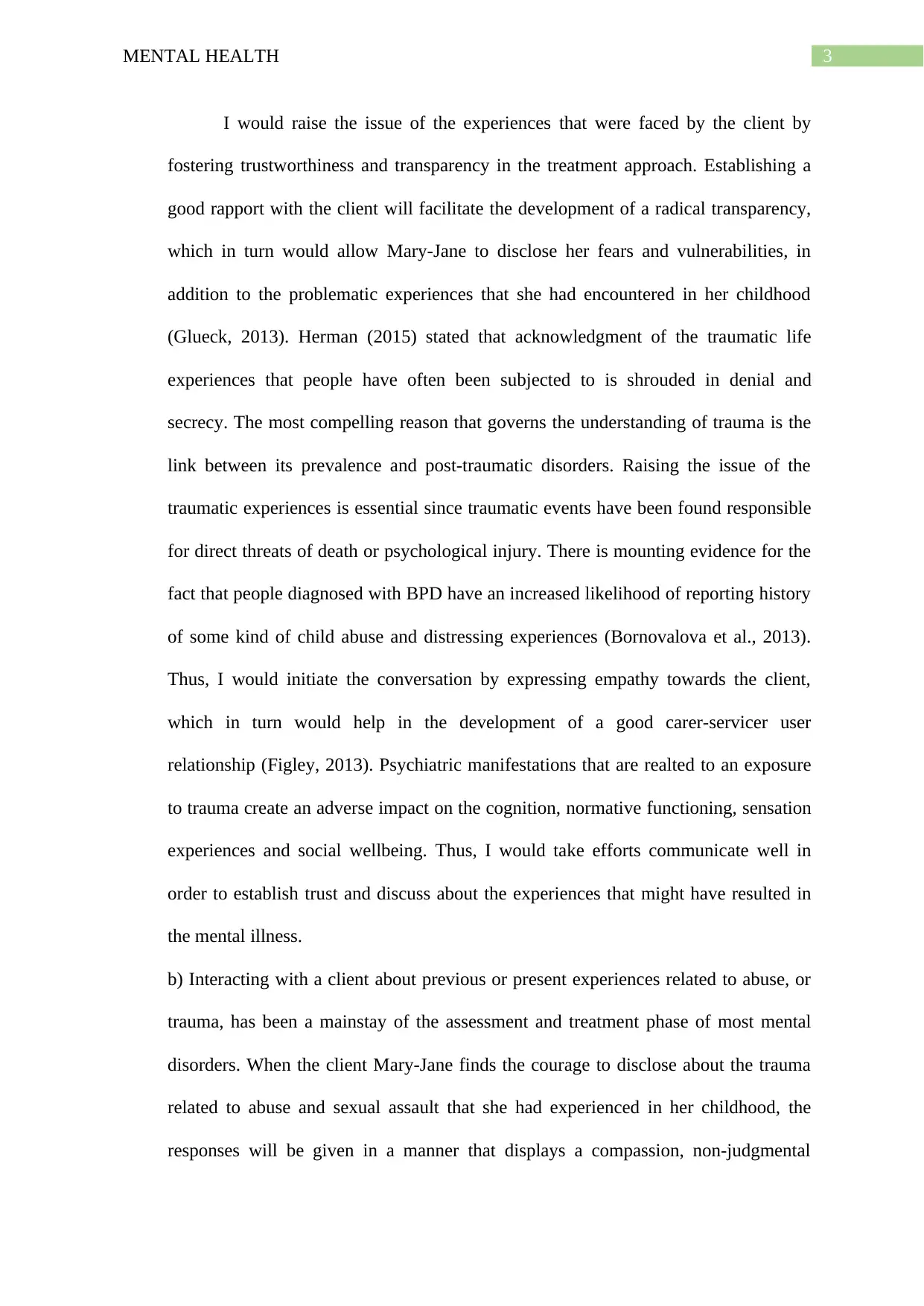
3MENTAL HEALTH
I would raise the issue of the experiences that were faced by the client by
fostering trustworthiness and transparency in the treatment approach. Establishing a
good rapport with the client will facilitate the development of a radical transparency,
which in turn would allow Mary-Jane to disclose her fears and vulnerabilities, in
addition to the problematic experiences that she had encountered in her childhood
(Glueck, 2013). Herman (2015) stated that acknowledgment of the traumatic life
experiences that people have often been subjected to is shrouded in denial and
secrecy. The most compelling reason that governs the understanding of trauma is the
link between its prevalence and post-traumatic disorders. Raising the issue of the
traumatic experiences is essential since traumatic events have been found responsible
for direct threats of death or psychological injury. There is mounting evidence for the
fact that people diagnosed with BPD have an increased likelihood of reporting history
of some kind of child abuse and distressing experiences (Bornovalova et al., 2013).
Thus, I would initiate the conversation by expressing empathy towards the client,
which in turn would help in the development of a good carer-servicer user
relationship (Figley, 2013). Psychiatric manifestations that are realted to an exposure
to trauma create an adverse impact on the cognition, normative functioning, sensation
experiences and social wellbeing. Thus, I would take efforts communicate well in
order to establish trust and discuss about the experiences that might have resulted in
the mental illness.
b) Interacting with a client about previous or present experiences related to abuse, or
trauma, has been a mainstay of the assessment and treatment phase of most mental
disorders. When the client Mary-Jane finds the courage to disclose about the trauma
related to abuse and sexual assault that she had experienced in her childhood, the
responses will be given in a manner that displays a compassion, non-judgmental
I would raise the issue of the experiences that were faced by the client by
fostering trustworthiness and transparency in the treatment approach. Establishing a
good rapport with the client will facilitate the development of a radical transparency,
which in turn would allow Mary-Jane to disclose her fears and vulnerabilities, in
addition to the problematic experiences that she had encountered in her childhood
(Glueck, 2013). Herman (2015) stated that acknowledgment of the traumatic life
experiences that people have often been subjected to is shrouded in denial and
secrecy. The most compelling reason that governs the understanding of trauma is the
link between its prevalence and post-traumatic disorders. Raising the issue of the
traumatic experiences is essential since traumatic events have been found responsible
for direct threats of death or psychological injury. There is mounting evidence for the
fact that people diagnosed with BPD have an increased likelihood of reporting history
of some kind of child abuse and distressing experiences (Bornovalova et al., 2013).
Thus, I would initiate the conversation by expressing empathy towards the client,
which in turn would help in the development of a good carer-servicer user
relationship (Figley, 2013). Psychiatric manifestations that are realted to an exposure
to trauma create an adverse impact on the cognition, normative functioning, sensation
experiences and social wellbeing. Thus, I would take efforts communicate well in
order to establish trust and discuss about the experiences that might have resulted in
the mental illness.
b) Interacting with a client about previous or present experiences related to abuse, or
trauma, has been a mainstay of the assessment and treatment phase of most mental
disorders. When the client Mary-Jane finds the courage to disclose about the trauma
related to abuse and sexual assault that she had experienced in her childhood, the
responses will be given in a manner that displays a compassion, non-judgmental
Secure Best Marks with AI Grader
Need help grading? Try our AI Grader for instant feedback on your assignments.

4MENTAL HEALTH
approach and helps in reducing shame in the client (Levy et al., 2014). Accepting
every aspect of the trauma faced by Mary-Jane as a part of her identity will be a
crucial step in this context. Health professionals hold certain personal views, beliefs
and prejudices. Being non-judgmental has often been identified as a crucial
professional responsibility, in regards to the obligation of bringing about a positive
change in the client. Bateman, Henderson & Kezelman (2013) opined that holistic and
non-judgmental care will promote her wellbeing and improve the mental and
emotional health. Offering words of comfort, assurance and support will also enhance
the ego-strengthening of the patient and facilitate her empowerment (Wall, Higgins &
Hunter, 2016). Using statements that shows apology for the distress that the client has
suffered or emphasising on the need of support are some of the sensitive responses
that might help Mary-Jane.
c) Retraumatisation refers to the unconscious or conscious reminder of traumatic
events that makes a sufferer re-experience the shock. Some of the major elements that
must be taken into consideration to avoid retraumatisation are trustworthiness, safety,
peer support, empowerment, and collaboration. Keller-Dupree (2013) stated that
being proactive and informing the client about the ways by which the trauma services
work will provide an occasion to make informed choices. Retraumatisation can also
be prevented by fostering autonomy of Mary-Jane, to get rid of her memories related
to previous violence and assault. Taking efforts to ask for suggestions from her on
steps that can make the entire interaction more comfortable and using grounded
techniques will also facilitate the action (Schock & Knaevelsrud, 2013). I would also
try to calmly remind her that she is currently safe and not in any danger of facing
abuse or assault. Moreover, restoration of a sense of control and providing the clients
with the opportunity of participating in informed decision making is crucial.
approach and helps in reducing shame in the client (Levy et al., 2014). Accepting
every aspect of the trauma faced by Mary-Jane as a part of her identity will be a
crucial step in this context. Health professionals hold certain personal views, beliefs
and prejudices. Being non-judgmental has often been identified as a crucial
professional responsibility, in regards to the obligation of bringing about a positive
change in the client. Bateman, Henderson & Kezelman (2013) opined that holistic and
non-judgmental care will promote her wellbeing and improve the mental and
emotional health. Offering words of comfort, assurance and support will also enhance
the ego-strengthening of the patient and facilitate her empowerment (Wall, Higgins &
Hunter, 2016). Using statements that shows apology for the distress that the client has
suffered or emphasising on the need of support are some of the sensitive responses
that might help Mary-Jane.
c) Retraumatisation refers to the unconscious or conscious reminder of traumatic
events that makes a sufferer re-experience the shock. Some of the major elements that
must be taken into consideration to avoid retraumatisation are trustworthiness, safety,
peer support, empowerment, and collaboration. Keller-Dupree (2013) stated that
being proactive and informing the client about the ways by which the trauma services
work will provide an occasion to make informed choices. Retraumatisation can also
be prevented by fostering autonomy of Mary-Jane, to get rid of her memories related
to previous violence and assault. Taking efforts to ask for suggestions from her on
steps that can make the entire interaction more comfortable and using grounded
techniques will also facilitate the action (Schock & Knaevelsrud, 2013). I would also
try to calmly remind her that she is currently safe and not in any danger of facing
abuse or assault. Moreover, restoration of a sense of control and providing the clients
with the opportunity of participating in informed decision making is crucial.
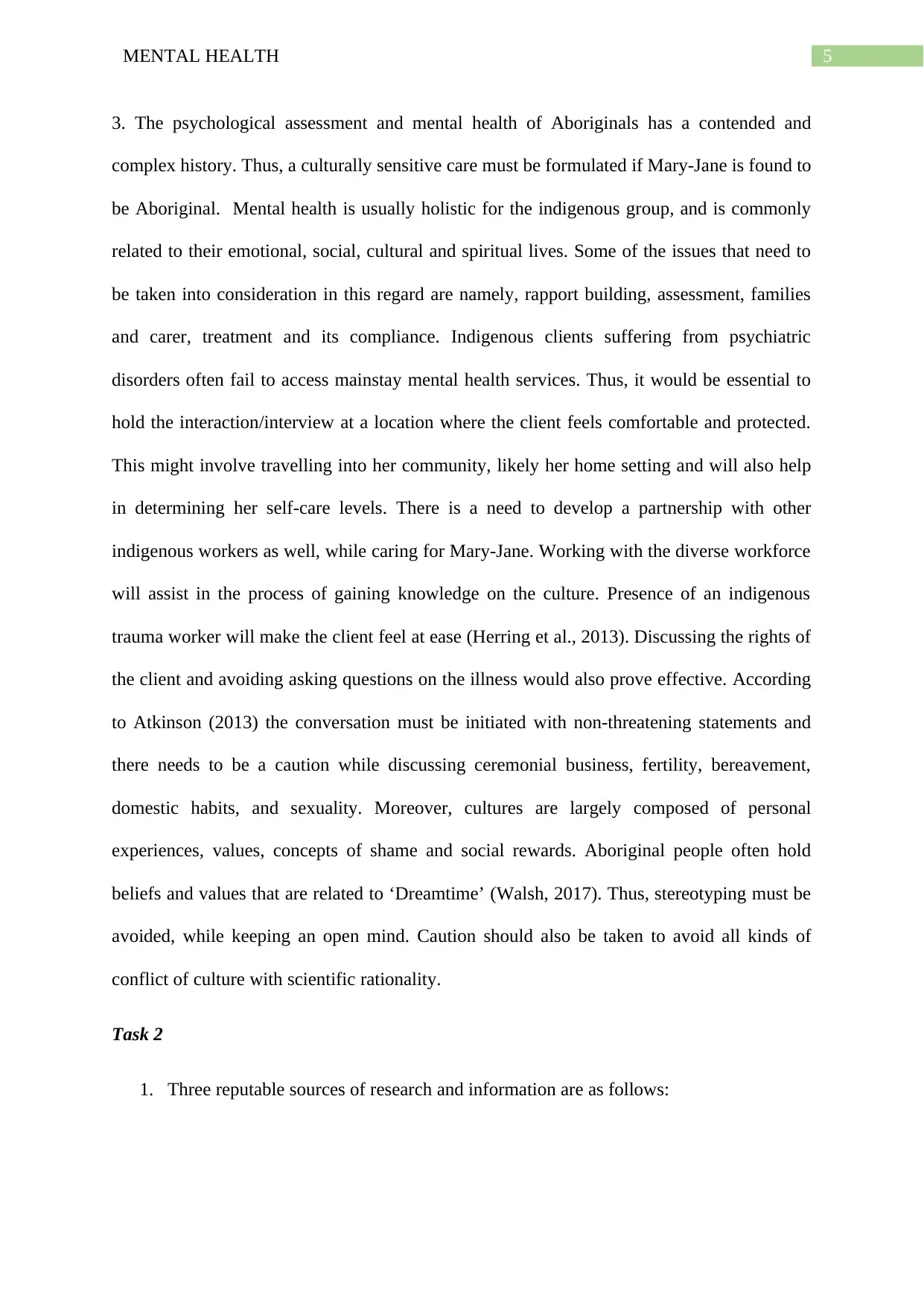
5MENTAL HEALTH
3. The psychological assessment and mental health of Aboriginals has a contended and
complex history. Thus, a culturally sensitive care must be formulated if Mary-Jane is found to
be Aboriginal. Mental health is usually holistic for the indigenous group, and is commonly
related to their emotional, social, cultural and spiritual lives. Some of the issues that need to
be taken into consideration in this regard are namely, rapport building, assessment, families
and carer, treatment and its compliance. Indigenous clients suffering from psychiatric
disorders often fail to access mainstay mental health services. Thus, it would be essential to
hold the interaction/interview at a location where the client feels comfortable and protected.
This might involve travelling into her community, likely her home setting and will also help
in determining her self-care levels. There is a need to develop a partnership with other
indigenous workers as well, while caring for Mary-Jane. Working with the diverse workforce
will assist in the process of gaining knowledge on the culture. Presence of an indigenous
trauma worker will make the client feel at ease (Herring et al., 2013). Discussing the rights of
the client and avoiding asking questions on the illness would also prove effective. According
to Atkinson (2013) the conversation must be initiated with non-threatening statements and
there needs to be a caution while discussing ceremonial business, fertility, bereavement,
domestic habits, and sexuality. Moreover, cultures are largely composed of personal
experiences, values, concepts of shame and social rewards. Aboriginal people often hold
beliefs and values that are related to ‘Dreamtime’ (Walsh, 2017). Thus, stereotyping must be
avoided, while keeping an open mind. Caution should also be taken to avoid all kinds of
conflict of culture with scientific rationality.
Task 2
1. Three reputable sources of research and information are as follows:
3. The psychological assessment and mental health of Aboriginals has a contended and
complex history. Thus, a culturally sensitive care must be formulated if Mary-Jane is found to
be Aboriginal. Mental health is usually holistic for the indigenous group, and is commonly
related to their emotional, social, cultural and spiritual lives. Some of the issues that need to
be taken into consideration in this regard are namely, rapport building, assessment, families
and carer, treatment and its compliance. Indigenous clients suffering from psychiatric
disorders often fail to access mainstay mental health services. Thus, it would be essential to
hold the interaction/interview at a location where the client feels comfortable and protected.
This might involve travelling into her community, likely her home setting and will also help
in determining her self-care levels. There is a need to develop a partnership with other
indigenous workers as well, while caring for Mary-Jane. Working with the diverse workforce
will assist in the process of gaining knowledge on the culture. Presence of an indigenous
trauma worker will make the client feel at ease (Herring et al., 2013). Discussing the rights of
the client and avoiding asking questions on the illness would also prove effective. According
to Atkinson (2013) the conversation must be initiated with non-threatening statements and
there needs to be a caution while discussing ceremonial business, fertility, bereavement,
domestic habits, and sexuality. Moreover, cultures are largely composed of personal
experiences, values, concepts of shame and social rewards. Aboriginal people often hold
beliefs and values that are related to ‘Dreamtime’ (Walsh, 2017). Thus, stereotyping must be
avoided, while keeping an open mind. Caution should also be taken to avoid all kinds of
conflict of culture with scientific rationality.
Task 2
1. Three reputable sources of research and information are as follows:
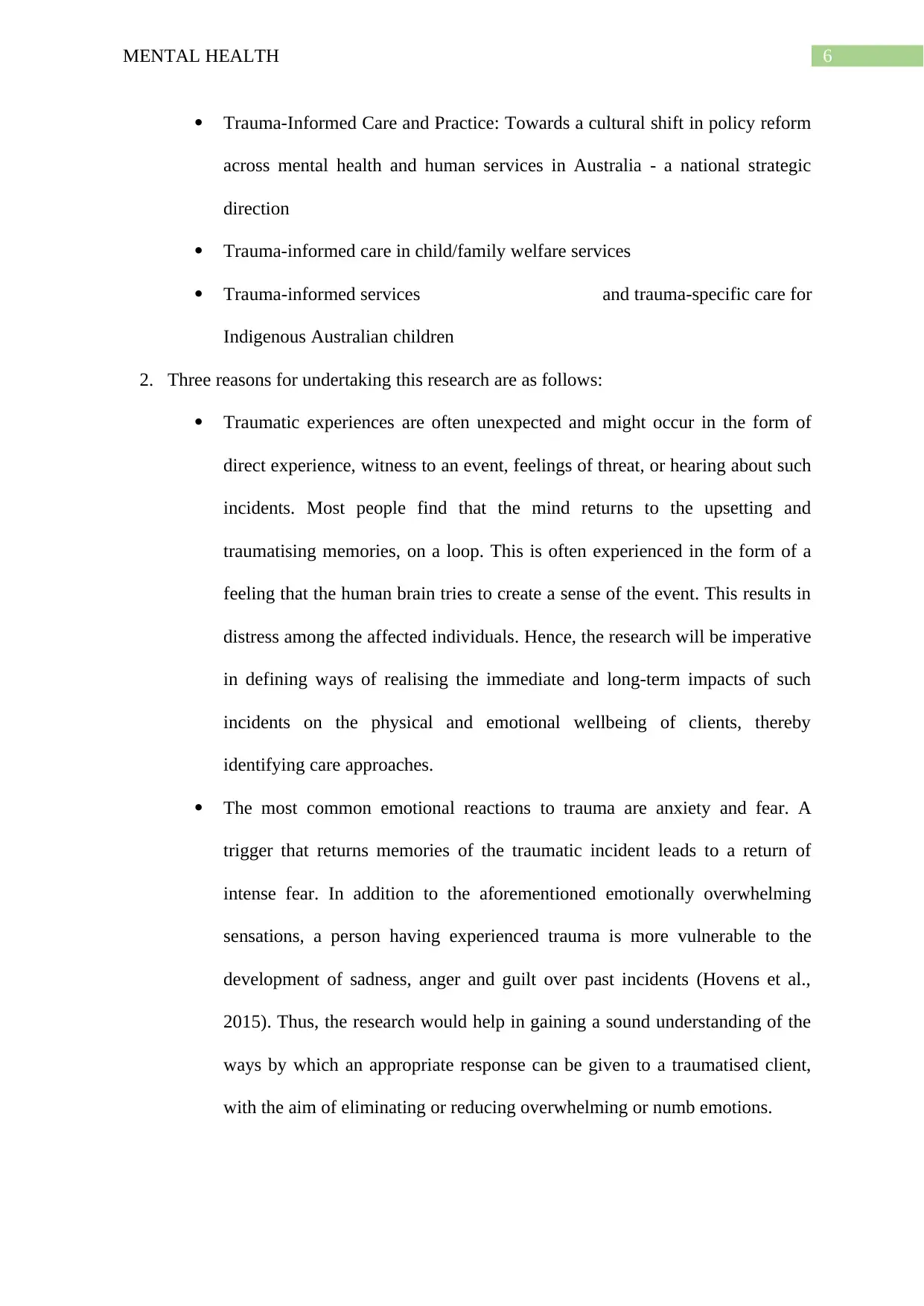
6MENTAL HEALTH
Trauma-Informed Care and Practice: Towards a cultural shift in policy reform
across mental health and human services in Australia - a national strategic
direction
Trauma-informed care in child/family welfare services
Trauma-informed services and trauma-specific care for
Indigenous Australian children
2. Three reasons for undertaking this research are as follows:
Traumatic experiences are often unexpected and might occur in the form of
direct experience, witness to an event, feelings of threat, or hearing about such
incidents. Most people find that the mind returns to the upsetting and
traumatising memories, on a loop. This is often experienced in the form of a
feeling that the human brain tries to create a sense of the event. This results in
distress among the affected individuals. Hence, the research will be imperative
in defining ways of realising the immediate and long-term impacts of such
incidents on the physical and emotional wellbeing of clients, thereby
identifying care approaches.
The most common emotional reactions to trauma are anxiety and fear. A
trigger that returns memories of the traumatic incident leads to a return of
intense fear. In addition to the aforementioned emotionally overwhelming
sensations, a person having experienced trauma is more vulnerable to the
development of sadness, anger and guilt over past incidents (Hovens et al.,
2015). Thus, the research would help in gaining a sound understanding of the
ways by which an appropriate response can be given to a traumatised client,
with the aim of eliminating or reducing overwhelming or numb emotions.
Trauma-Informed Care and Practice: Towards a cultural shift in policy reform
across mental health and human services in Australia - a national strategic
direction
Trauma-informed care in child/family welfare services
Trauma-informed services and trauma-specific care for
Indigenous Australian children
2. Three reasons for undertaking this research are as follows:
Traumatic experiences are often unexpected and might occur in the form of
direct experience, witness to an event, feelings of threat, or hearing about such
incidents. Most people find that the mind returns to the upsetting and
traumatising memories, on a loop. This is often experienced in the form of a
feeling that the human brain tries to create a sense of the event. This results in
distress among the affected individuals. Hence, the research will be imperative
in defining ways of realising the immediate and long-term impacts of such
incidents on the physical and emotional wellbeing of clients, thereby
identifying care approaches.
The most common emotional reactions to trauma are anxiety and fear. A
trigger that returns memories of the traumatic incident leads to a return of
intense fear. In addition to the aforementioned emotionally overwhelming
sensations, a person having experienced trauma is more vulnerable to the
development of sadness, anger and guilt over past incidents (Hovens et al.,
2015). Thus, the research would help in gaining a sound understanding of the
ways by which an appropriate response can be given to a traumatised client,
with the aim of eliminating or reducing overwhelming or numb emotions.
Paraphrase This Document
Need a fresh take? Get an instant paraphrase of this document with our AI Paraphraser

7MENTAL HEALTH
Implementation of certain trauma-informed services will greatly assist in the
screening and assessment of individuals at-risk and will also help in reducing
chances for retraumatisation. Undertaking a research on the same will also
help in identifying the culturally appropriate strategies that can be put to place
for reducing chances of misunderstanding the presenting complaints or
underestimation of need for referrals.
3. Three ways by which the validity of the internet sources can be evaluated are:
Determining the credentials and affiliation of the publishers and authors and
checking for the presence of a reputable organisation behind them
Determining the scope of the information such as, their usefulness, accuracy,
and factual statements
Assessing whether the site is easily browsable and the target audience is
clearly indicated
4. The three processes for analysis of information are as follows:
Defining the research question and setting the measurement priorities
Collecting data
Manipulating the data by finding correlations and interpreting the results
Thus, I would initially define the trauma-care related research question that I intend to
investigate, followed by collection of relevant information from scholarly sources and
medical guidelines. I will then organise the data findings into definite patterns or
themes to draw a relevant conclusion.
Task 3
1. Two internal network connections for improvement of professional practice are peer
support and guidance from supervisors. Peer support will increase the levels of self-
Implementation of certain trauma-informed services will greatly assist in the
screening and assessment of individuals at-risk and will also help in reducing
chances for retraumatisation. Undertaking a research on the same will also
help in identifying the culturally appropriate strategies that can be put to place
for reducing chances of misunderstanding the presenting complaints or
underestimation of need for referrals.
3. Three ways by which the validity of the internet sources can be evaluated are:
Determining the credentials and affiliation of the publishers and authors and
checking for the presence of a reputable organisation behind them
Determining the scope of the information such as, their usefulness, accuracy,
and factual statements
Assessing whether the site is easily browsable and the target audience is
clearly indicated
4. The three processes for analysis of information are as follows:
Defining the research question and setting the measurement priorities
Collecting data
Manipulating the data by finding correlations and interpreting the results
Thus, I would initially define the trauma-care related research question that I intend to
investigate, followed by collection of relevant information from scholarly sources and
medical guidelines. I will then organise the data findings into definite patterns or
themes to draw a relevant conclusion.
Task 3
1. Two internal network connections for improvement of professional practice are peer
support and guidance from supervisors. Peer support will increase the levels of self-
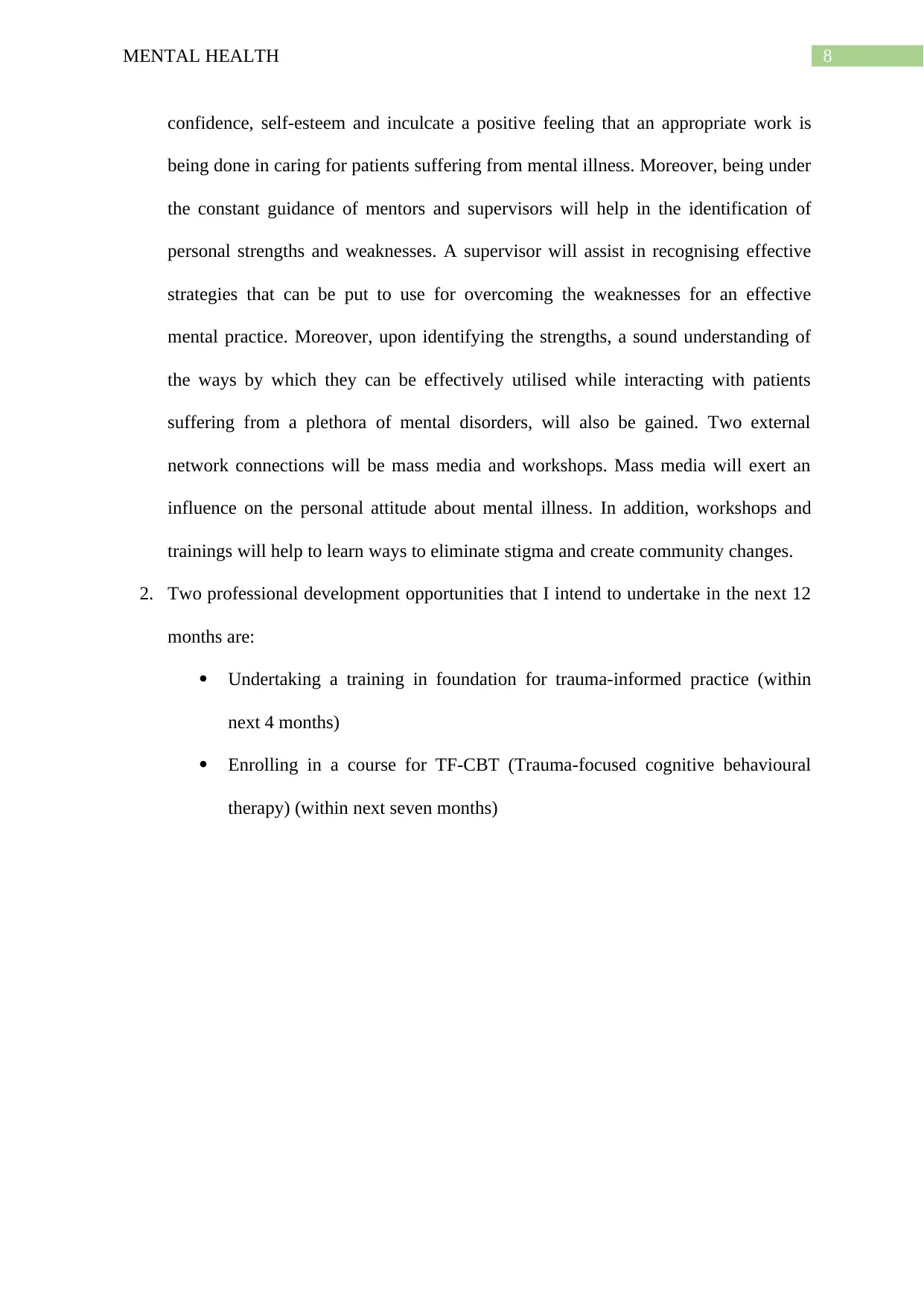
8MENTAL HEALTH
confidence, self-esteem and inculcate a positive feeling that an appropriate work is
being done in caring for patients suffering from mental illness. Moreover, being under
the constant guidance of mentors and supervisors will help in the identification of
personal strengths and weaknesses. A supervisor will assist in recognising effective
strategies that can be put to use for overcoming the weaknesses for an effective
mental practice. Moreover, upon identifying the strengths, a sound understanding of
the ways by which they can be effectively utilised while interacting with patients
suffering from a plethora of mental disorders, will also be gained. Two external
network connections will be mass media and workshops. Mass media will exert an
influence on the personal attitude about mental illness. In addition, workshops and
trainings will help to learn ways to eliminate stigma and create community changes.
2. Two professional development opportunities that I intend to undertake in the next 12
months are:
Undertaking a training in foundation for trauma-informed practice (within
next 4 months)
Enrolling in a course for TF-CBT (Trauma-focused cognitive behavioural
therapy) (within next seven months)
confidence, self-esteem and inculcate a positive feeling that an appropriate work is
being done in caring for patients suffering from mental illness. Moreover, being under
the constant guidance of mentors and supervisors will help in the identification of
personal strengths and weaknesses. A supervisor will assist in recognising effective
strategies that can be put to use for overcoming the weaknesses for an effective
mental practice. Moreover, upon identifying the strengths, a sound understanding of
the ways by which they can be effectively utilised while interacting with patients
suffering from a plethora of mental disorders, will also be gained. Two external
network connections will be mass media and workshops. Mass media will exert an
influence on the personal attitude about mental illness. In addition, workshops and
trainings will help to learn ways to eliminate stigma and create community changes.
2. Two professional development opportunities that I intend to undertake in the next 12
months are:
Undertaking a training in foundation for trauma-informed practice (within
next 4 months)
Enrolling in a course for TF-CBT (Trauma-focused cognitive behavioural
therapy) (within next seven months)
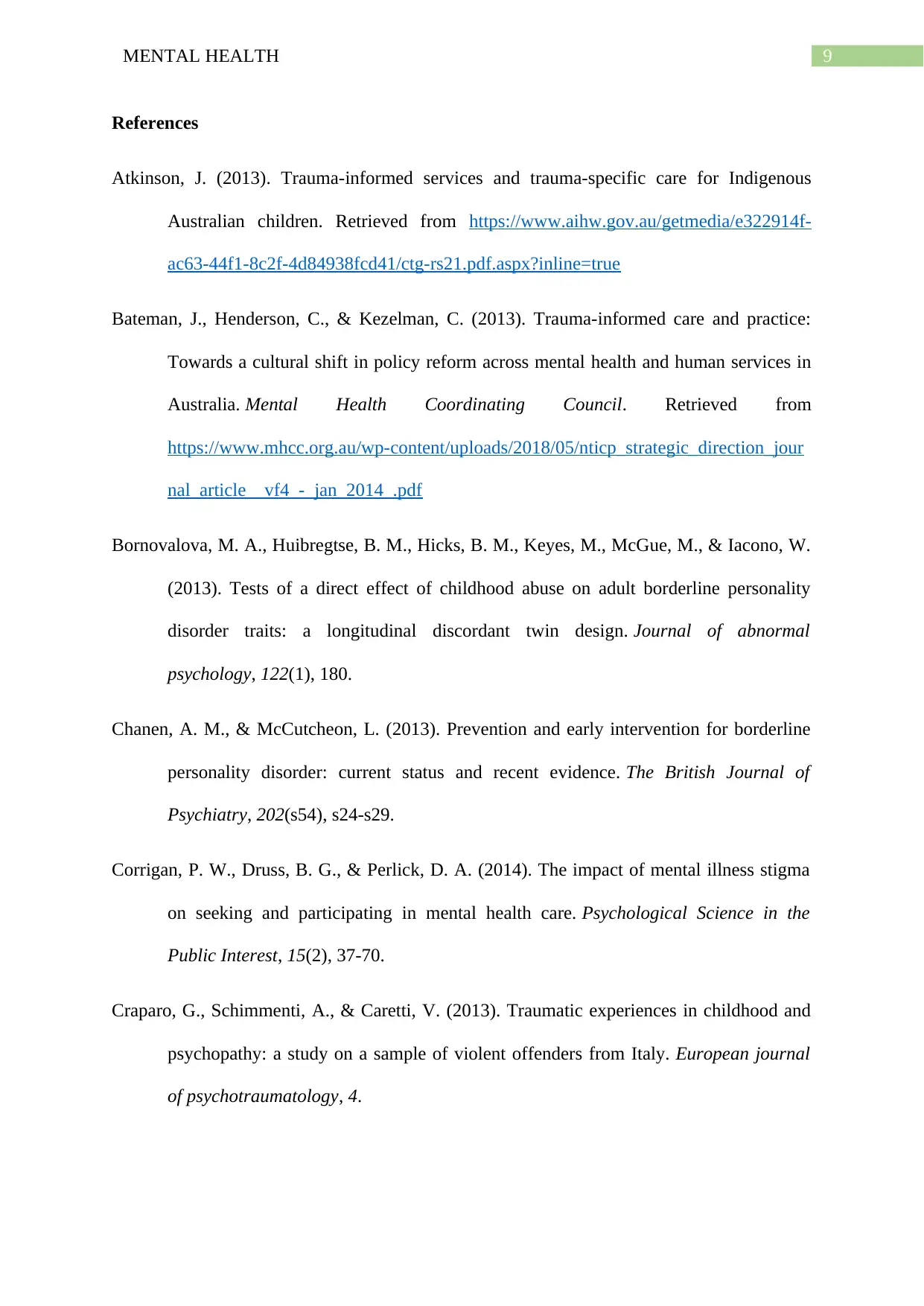
9MENTAL HEALTH
References
Atkinson, J. (2013). Trauma-informed services and trauma-specific care for Indigenous
Australian children. Retrieved from https://www.aihw.gov.au/getmedia/e322914f-
ac63-44f1-8c2f-4d84938fcd41/ctg-rs21.pdf.aspx?inline=true
Bateman, J., Henderson, C., & Kezelman, C. (2013). Trauma-informed care and practice:
Towards a cultural shift in policy reform across mental health and human services in
Australia. Mental Health Coordinating Council. Retrieved from
https://www.mhcc.org.au/wp-content/uploads/2018/05/nticp_strategic_direction_jour
nal_article__vf4_-_jan_2014_.pdf
Bornovalova, M. A., Huibregtse, B. M., Hicks, B. M., Keyes, M., McGue, M., & Iacono, W.
(2013). Tests of a direct effect of childhood abuse on adult borderline personality
disorder traits: a longitudinal discordant twin design. Journal of abnormal
psychology, 122(1), 180.
Chanen, A. M., & McCutcheon, L. (2013). Prevention and early intervention for borderline
personality disorder: current status and recent evidence. The British Journal of
Psychiatry, 202(s54), s24-s29.
Corrigan, P. W., Druss, B. G., & Perlick, D. A. (2014). The impact of mental illness stigma
on seeking and participating in mental health care. Psychological Science in the
Public Interest, 15(2), 37-70.
Craparo, G., Schimmenti, A., & Caretti, V. (2013). Traumatic experiences in childhood and
psychopathy: a study on a sample of violent offenders from Italy. European journal
of psychotraumatology, 4.
References
Atkinson, J. (2013). Trauma-informed services and trauma-specific care for Indigenous
Australian children. Retrieved from https://www.aihw.gov.au/getmedia/e322914f-
ac63-44f1-8c2f-4d84938fcd41/ctg-rs21.pdf.aspx?inline=true
Bateman, J., Henderson, C., & Kezelman, C. (2013). Trauma-informed care and practice:
Towards a cultural shift in policy reform across mental health and human services in
Australia. Mental Health Coordinating Council. Retrieved from
https://www.mhcc.org.au/wp-content/uploads/2018/05/nticp_strategic_direction_jour
nal_article__vf4_-_jan_2014_.pdf
Bornovalova, M. A., Huibregtse, B. M., Hicks, B. M., Keyes, M., McGue, M., & Iacono, W.
(2013). Tests of a direct effect of childhood abuse on adult borderline personality
disorder traits: a longitudinal discordant twin design. Journal of abnormal
psychology, 122(1), 180.
Chanen, A. M., & McCutcheon, L. (2013). Prevention and early intervention for borderline
personality disorder: current status and recent evidence. The British Journal of
Psychiatry, 202(s54), s24-s29.
Corrigan, P. W., Druss, B. G., & Perlick, D. A. (2014). The impact of mental illness stigma
on seeking and participating in mental health care. Psychological Science in the
Public Interest, 15(2), 37-70.
Craparo, G., Schimmenti, A., & Caretti, V. (2013). Traumatic experiences in childhood and
psychopathy: a study on a sample of violent offenders from Italy. European journal
of psychotraumatology, 4.
Secure Best Marks with AI Grader
Need help grading? Try our AI Grader for instant feedback on your assignments.
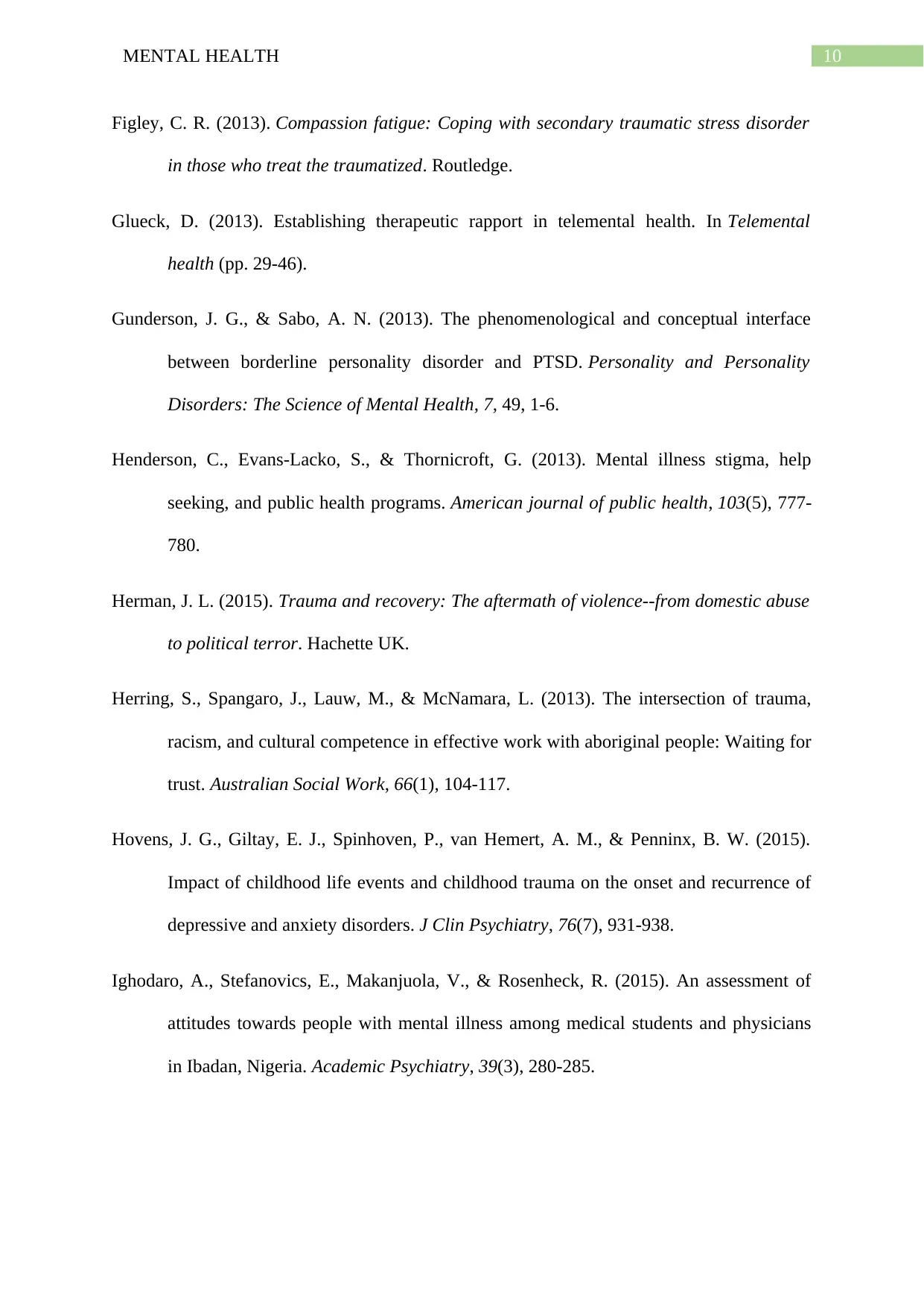
10MENTAL HEALTH
Figley, C. R. (2013). Compassion fatigue: Coping with secondary traumatic stress disorder
in those who treat the traumatized. Routledge.
Glueck, D. (2013). Establishing therapeutic rapport in telemental health. In Telemental
health (pp. 29-46).
Gunderson, J. G., & Sabo, A. N. (2013). The phenomenological and conceptual interface
between borderline personality disorder and PTSD. Personality and Personality
Disorders: The Science of Mental Health, 7, 49, 1-6.
Henderson, C., Evans-Lacko, S., & Thornicroft, G. (2013). Mental illness stigma, help
seeking, and public health programs. American journal of public health, 103(5), 777-
780.
Herman, J. L. (2015). Trauma and recovery: The aftermath of violence--from domestic abuse
to political terror. Hachette UK.
Herring, S., Spangaro, J., Lauw, M., & McNamara, L. (2013). The intersection of trauma,
racism, and cultural competence in effective work with aboriginal people: Waiting for
trust. Australian Social Work, 66(1), 104-117.
Hovens, J. G., Giltay, E. J., Spinhoven, P., van Hemert, A. M., & Penninx, B. W. (2015).
Impact of childhood life events and childhood trauma on the onset and recurrence of
depressive and anxiety disorders. J Clin Psychiatry, 76(7), 931-938.
Ighodaro, A., Stefanovics, E., Makanjuola, V., & Rosenheck, R. (2015). An assessment of
attitudes towards people with mental illness among medical students and physicians
in Ibadan, Nigeria. Academic Psychiatry, 39(3), 280-285.
Figley, C. R. (2013). Compassion fatigue: Coping with secondary traumatic stress disorder
in those who treat the traumatized. Routledge.
Glueck, D. (2013). Establishing therapeutic rapport in telemental health. In Telemental
health (pp. 29-46).
Gunderson, J. G., & Sabo, A. N. (2013). The phenomenological and conceptual interface
between borderline personality disorder and PTSD. Personality and Personality
Disorders: The Science of Mental Health, 7, 49, 1-6.
Henderson, C., Evans-Lacko, S., & Thornicroft, G. (2013). Mental illness stigma, help
seeking, and public health programs. American journal of public health, 103(5), 777-
780.
Herman, J. L. (2015). Trauma and recovery: The aftermath of violence--from domestic abuse
to political terror. Hachette UK.
Herring, S., Spangaro, J., Lauw, M., & McNamara, L. (2013). The intersection of trauma,
racism, and cultural competence in effective work with aboriginal people: Waiting for
trust. Australian Social Work, 66(1), 104-117.
Hovens, J. G., Giltay, E. J., Spinhoven, P., van Hemert, A. M., & Penninx, B. W. (2015).
Impact of childhood life events and childhood trauma on the onset and recurrence of
depressive and anxiety disorders. J Clin Psychiatry, 76(7), 931-938.
Ighodaro, A., Stefanovics, E., Makanjuola, V., & Rosenheck, R. (2015). An assessment of
attitudes towards people with mental illness among medical students and physicians
in Ibadan, Nigeria. Academic Psychiatry, 39(3), 280-285.
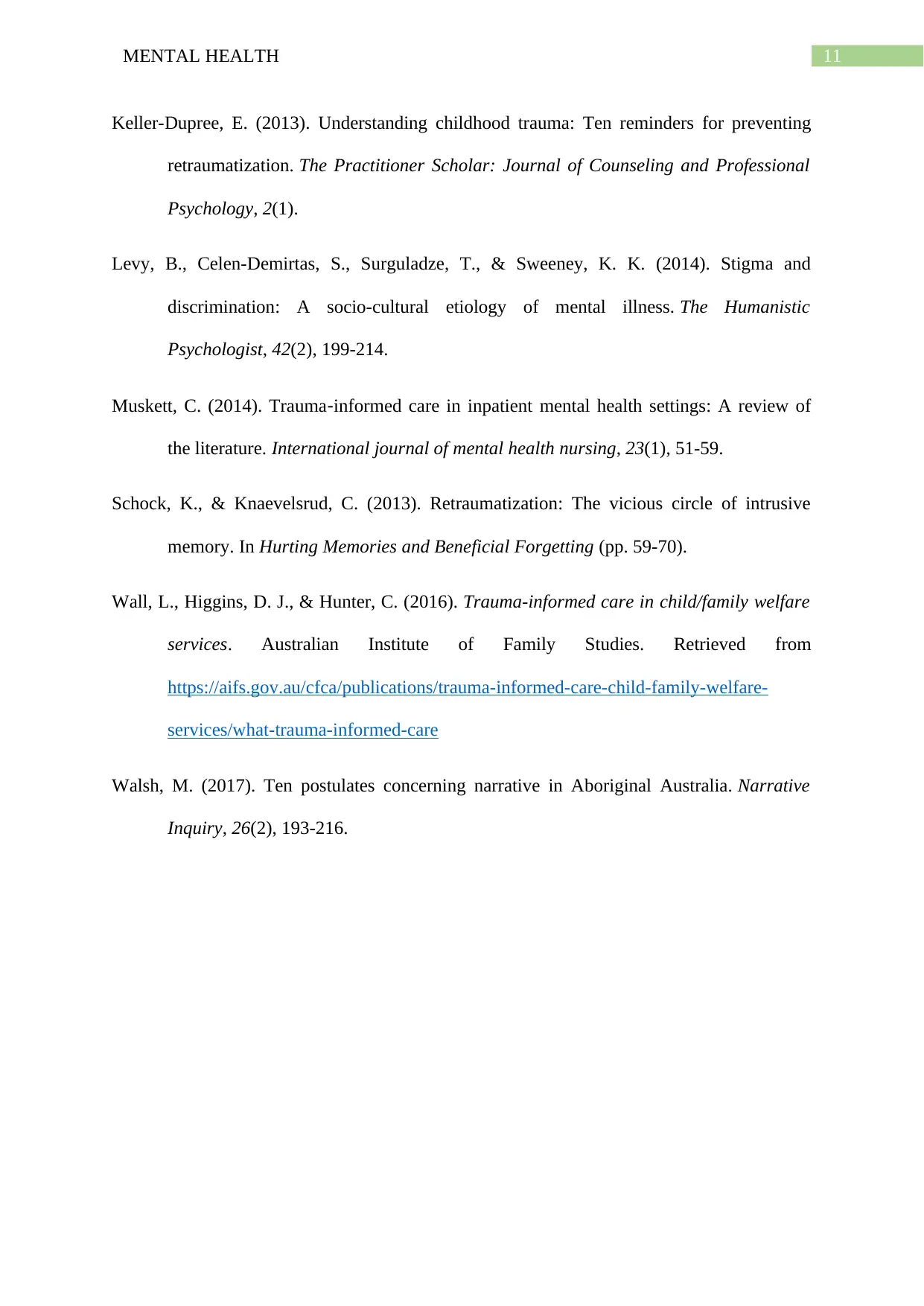
11MENTAL HEALTH
Keller-Dupree, E. (2013). Understanding childhood trauma: Ten reminders for preventing
retraumatization. The Practitioner Scholar: Journal of Counseling and Professional
Psychology, 2(1).
Levy, B., Celen-Demirtas, S., Surguladze, T., & Sweeney, K. K. (2014). Stigma and
discrimination: A socio-cultural etiology of mental illness. The Humanistic
Psychologist, 42(2), 199-214.
Muskett, C. (2014). Trauma‐informed care in inpatient mental health settings: A review of
the literature. International journal of mental health nursing, 23(1), 51-59.
Schock, K., & Knaevelsrud, C. (2013). Retraumatization: The vicious circle of intrusive
memory. In Hurting Memories and Beneficial Forgetting (pp. 59-70).
Wall, L., Higgins, D. J., & Hunter, C. (2016). Trauma-informed care in child/family welfare
services. Australian Institute of Family Studies. Retrieved from
https://aifs.gov.au/cfca/publications/trauma-informed-care-child-family-welfare-
services/what-trauma-informed-care
Walsh, M. (2017). Ten postulates concerning narrative in Aboriginal Australia. Narrative
Inquiry, 26(2), 193-216.
Keller-Dupree, E. (2013). Understanding childhood trauma: Ten reminders for preventing
retraumatization. The Practitioner Scholar: Journal of Counseling and Professional
Psychology, 2(1).
Levy, B., Celen-Demirtas, S., Surguladze, T., & Sweeney, K. K. (2014). Stigma and
discrimination: A socio-cultural etiology of mental illness. The Humanistic
Psychologist, 42(2), 199-214.
Muskett, C. (2014). Trauma‐informed care in inpatient mental health settings: A review of
the literature. International journal of mental health nursing, 23(1), 51-59.
Schock, K., & Knaevelsrud, C. (2013). Retraumatization: The vicious circle of intrusive
memory. In Hurting Memories and Beneficial Forgetting (pp. 59-70).
Wall, L., Higgins, D. J., & Hunter, C. (2016). Trauma-informed care in child/family welfare
services. Australian Institute of Family Studies. Retrieved from
https://aifs.gov.au/cfca/publications/trauma-informed-care-child-family-welfare-
services/what-trauma-informed-care
Walsh, M. (2017). Ten postulates concerning narrative in Aboriginal Australia. Narrative
Inquiry, 26(2), 193-216.
1 out of 12
Related Documents
Your All-in-One AI-Powered Toolkit for Academic Success.
+13062052269
info@desklib.com
Available 24*7 on WhatsApp / Email
![[object Object]](/_next/static/media/star-bottom.7253800d.svg)
Unlock your academic potential
© 2024 | Zucol Services PVT LTD | All rights reserved.





